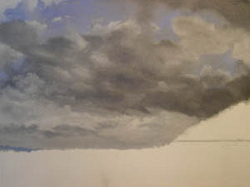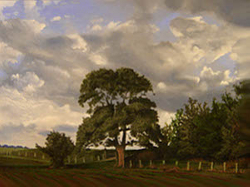
“The Field’s Edge” was a milestone painting for me and my 10th painting. A professional artist once told me I should see a noticeable improvement in my ability after every ten paintings. He must have been right because this painting was the 10th oil painting I ever completed. Another factor that might have been at play was my daughter was seriously ill at the time with a life-threatening blood infection, and I might have been releasing all that stress and anxiety into the painting. Please enjoy this tutorial “The Field’s Edge” by John O’Keefe Jr.
Composition and Materials – “The Field’s Edge”

I’m a big fan of the Hudson River School painters, and because of this, I have been trying to develop similar skills in landscape painting. Also, the clouds in this scene are from my wife’s photograph and a picture from the wetcanvas.com reference library for the field and trees, and these combined to make a good composition for me.
I switched from Winsor & Newton Winton to Winsor & Newton Artist Oil Color and experienced a big difference in colors, mixing, and how the paint goes onto the canvas. Professional-grade oil paints are preferred over student-grade paints. I limited myself to a six-color pallet (see below) and used NO mediums; the paint was straight out of the tubes. The green of choice was Sap Green mixed with Titanium White or Ivory Black. Added to this was a little Raw Umber or Raw Sienna to add some earthy tones. Also, I added the sap green straight onto the canvas in the grass running across the middle of the painting. Of course, it had blended a little as I was painting wet on wet.
I put about 25 hours into this painting spread over five days: about 5 hours daily, including prep and clean up. Also worth mentioning is that I painted sitting under a 60-watt incandescent light bulb with not much natural outside light shining on the canvas as I worked.
- Support: Pre-Stretched & Mounted Medium Textured Cotton Canvas (Acrylic Primed)
- Size: 12 x 16 inch
- Medium: Winsor & Newton Artist Oils Professional Grade Oil Paints
(Sky/Clouds: Titanium White, Ivory Black, and Ultramarine Blue)
(Landscape: Titanium White, Ivory Black, Sap Green, Raw Umber, Raw Sienna, Alizarin Crimson, and Napals Yellow) - Finish: Winsor & Newton Dammar varnish
Step-By-Step Tutorial – “The Field’s Edge”
Day 1

I began this painting with the most distant objects: the sky and clouds. These were aggressive clouds that were very busy.
Day 2

The clouds needed refinement, so I kept working with a blending brush until they flowed smoothly and improved the contrast between light and dark areas. However, at this point, things looked a little stormy.
Day 3

Notice the final white highlights added to the clouds, removing the dark feel from Day 2. It now looks like a bright sunny day. I also added the ground and the beginning of the tree line, and I intended to have a powerful contrast between light and dark. Notice its effect when comparing the ground objects against the sky.
Day 4

The big tree is complete, and now it’s time to work on the tree line to the right. I slightly modified each tree’s colors to make the multiple trees stand apart, and I added green to some and brown and red to others. The overall effect is to give a sense of many trees growing together. Adding the right amount of darkness to areas proved more difficult than I initially thought. I continued to make adjustments by increasing darker areas, such as under the trees.
Day 5

It was a perfect sunny day. The puffy clouds and the darker patches are nothing more than deep shadows. There was not a drop of rain in the sky that day. Furthermore, I have been working on achieving the correct/accurate balance between light and dark areas in my landscape paintings, and it’s incredible how much of both are present even on a very sunny day. When I would sit at the end of the day and review my painting against the reference photo, I noticed how much lighter my painting seemed. I had not put enough contrast between light and dark objects.
The painting became more realistic as I continued to retouch those lighter areas by adding more shadows. Also, I have seen many paintings that do not have enough contrast between objects, and these paintings always seem to be missing something to me; they lose depth and appear flat. For example: Instead of using darker green for shadows under the trees, I saw a more realistic painting emerge when I painted straight black into those areas. I’m learning not to be so afraid of using darks.
Finished Painting – “The Field’s Edge”


I hope you enjoyed this tutorial “The Field’s Edge” by John O’Keefe Jr.

That was impressive you explained it marvelously and I actually understood, thank you. The painting was wonderful and reading how the process worked was very enlightening.